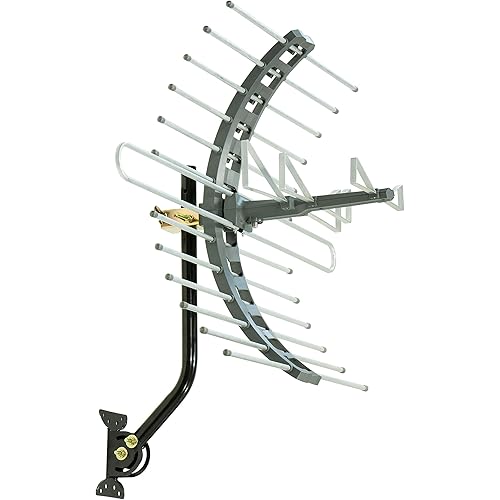Antennas Direct 8-Element Bowtie UHF Outdoor HDTV Antenna, Multi-Directional, 70+ Mile Range, 4K 8K UHD NEXTGEN TV – w/All-Weather Mounting Hardware










Buy Now, Pay Later
- – 6-month term
- – No impact on credit
- – Instant approval decision
- – Secure and straightforward checkout
Ready to go? Add this product to your cart and select a plan during checkout.
Payment plans are offered through our trusted finance partners Klarna, Affirm, Afterpay, Apple Pay, and PayTomorrow. No-credit-needed leasing options through Acima may also be available at checkout.
Learn more about financing & leasing here.
Selected Option
30-day refund/replacement
To qualify for a full refund, items must be returned in their original, unused condition. If an item is returned in a used, damaged, or materially different state, you may be granted a partial refund.
To initiate a return, please visit our Returns Center.
View our full returns policy here.
Recently Viewed
Style: 70 Mile
Features
- Antennas Direct 8-Element Bowtie HDTV antenna - Has a range of 70+ miles and patented, multi-directional, specially designed brackets that allow the antenna to turn in different directions to target transmitting towers
- Bowtie antenna measures 36.8" H x 50" W x 10" D; ideal for rural and suburban installations challenged by heavy foliage or roofing materials
- Compatibility - NEXTGEN TV, 4K, 8K UHD, Full HD 1080p, no Internet required
- Each market has TV towers located in different areas; Distance to the towers and obstructions like trees and your homes building materials will affect reception
- Reflectors add forward gain and focus the antenna's power to protect incoming TV signal from interference that causes pixelation or complete loss of picture
- Includes 8-element bowtie antenna, reflector panels, all-weather mounting hardware, adjustable mast clamp, instructions; Compatible with VHF kit for Hi-VHF reception; Lifetime manufacturer warranty
- Based in St. Louis, MO., Antennas Direct is dedicated to providing superior digital antennas and accessories engineered in the USA
Description
The Antennas Direct 8-Element Bowtie antenna is a high-performance UHF antenna array with a range of 70+ miles and unsurpassed gain of 17.4 dB. This multi- directional bowtie HDTV antenna features specially designed brackets which allow the two antenna panels to turn in different directions to target broadcast television towers, so you get more free TV channels even if your towers are spread out. Antennas Direct has brought the Bowtie outdoor TV antenna into the 21st century with patented design which allows for easy installation options that are off-limits to much larger antennas. Ideal for rural and suburban installations challenged with pulling in signals through heavy foliage or roofing materials when TV towers are far away. The reflectors add forward gain and focus the antenna's power to protect the incoming TV signal from interference that causes pixelation or a complete loss of picture. Compatible with our VHF kit for even more channels. If you had cable or satellite installed before, the coaxial cable needed to distribute signal throughout your home may already be installed – simply connect the DB8-e to the existing coaxial cable and you’ve got free local TV from the networks. Find your TV channels and towers on our website or using our free Antenna Point app on android or iOS devices. Coaxial cable and mast sold separately. Details: Range: 70+ Miles; Location: Attic / Outdoor; Style: Multi- Directional; Frequency: UHF 470 - 608 MHz; Peak Gain: 17.4 dBi; Beam Angle: 16.3 Degree Horizontal Reception Pattern; Antenna Dimensions: 36.8"H x 50"W x 10"D; Weight: 9.4 lbs.; Color: Silver; Includes: All-weather mounting hardware, adjustable mast clamp. Lifetime manufacturer warranty. Antennas Direct has helped millions of people cut the cord since 2003. As the pioneers who reinvented the digital TV antenna industry, we believe that high-quality TV antennas can and should deliver performance and reliable reception of free broadcast TV signals at an affordable price.
Antenna: Television
Brand: Antennas Direct
Color: Silver
Impedance: 75 Ohm
Maximum Range: 70 Miles
Product Dimensions: 36"L x 6"W x 48"H
UPC:
Manufacturer: Antennas Direct, Inc.
Global Trade Identification Number: 20, 20
Number of Items: 1
Product Dimensions: 36 x 6 x 48 inches
Item Weight: 10 pounds
Manufacturer: Antennas Direct, Inc.
Country of Origin: Taiwan
Item model number: DB8e
Is Discontinued By Manufacturer: No
Date First Available: July 1, 2013
Frequently asked questions
To initiate a return, please visit our Returns Center.
View our full returns policy here.
- Klarna Financing
- Affirm Pay in 4
- Affirm Financing
- Afterpay Financing
- PayTomorrow Financing
- Financing through Apple Pay
Learn more about financing & leasing here.

























